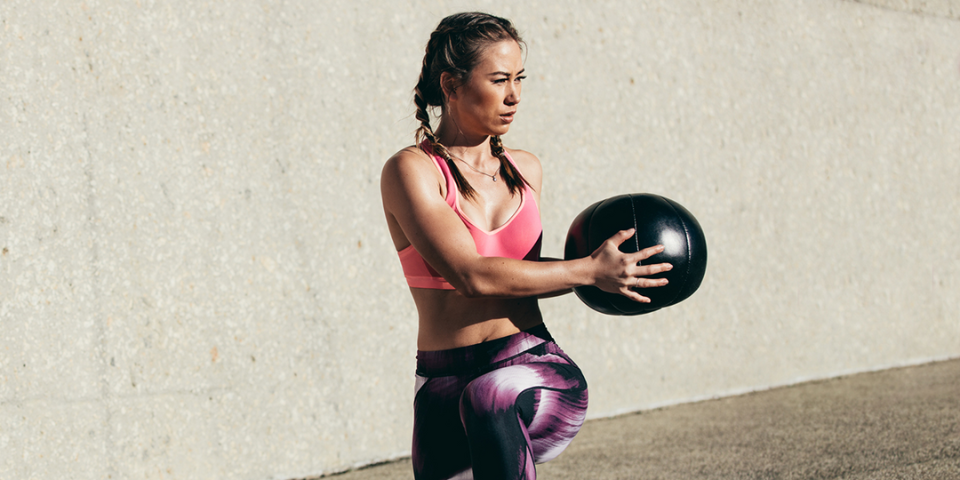11 Tips to Set Realistic Fitness Goals You’ll Actually Achieve, According to Top Trainers

Because smart planning at the start can set you up for long-term success.
.jpg)
Oleg Breslavstev/Getty Images
All products are independently selected by our editors. If you buy something, we may earn an affiliate commission.
Whether you’re a lifelong athlete or totally new to exercising, the start of a new year always marks a boom in fitness-related resolutions. “Exercise more” even ranked among the top five resolutions for 2024, according to a YouGov.org poll of 1,000 people. (And, of course, this kind of goal-setting doesn’t need to be tied to New Year’s; it can be done any time you’re looking to add some movement to your life.) Done right, this can be an invaluable tool for advancing in your fitness journey—it can help structure workouts, keep you on track, measure progress, and motivate you to continue—but it can be surprisingly tough to find a happy medium between ambitious and far-fetched. And treading that fine line is key to success.
“People often take that ‘New year, new you’ thing very seriously,” certified personal trainer Francine Delgado-Lugo, CPT, movement and strength coach and cofounder of Form Fitness Brooklyn, tells SELF. But for fitness to stick around for the long haul, you want it to be something that works for the actual you, not a version you’re hoping to become. Now, this doesn’t mean that change isn’t possible—it definitely is. But at the same time, setting a lofty, unsustainable, or otherwise unrealistic goal can set you up for failure right out of the gate. And that failure, in turn, can trigger a downward spiral that can leave you feeling pretty down about yourself and what you can do.
Fitness shouldn’t make you feel lousy—in fact, once you get into it, it packs a ton of mood-boosting benefits. So to help you take the plunge, we tapped experts for their best tips on how to set great fitness goals. Read on for what to keep in mind as you get started crafting the very best ones for you—you know, the ones that are both worthwhile and workable.
1. Focus on one goal at a time.
When it comes to setting a fitness goal, “one of the biggest mistakes is that people try to do too much at one time,” Kellen Scantlebury, DPT, certified strength and conditioning specialist and founder of Fit Club NY, tells SELF. Perhaps you want to hit the gym every day, meal-prep for each and every workday lunch, and get at least eight hours of sleep a night. Tackling that much at once is essentially just a recipe for disaster. With so many things looming in front of them, “people get anxious, and if they didn’t do one thing, they feel like a failure,” says Dr. Scantlebury. This can lead to negative self-talk that lowers your chances of achieving any of the goals.
Instead, pick one thing you really want to crush—like doing a pull-up or completing your first-ever 5K—and channel your efforts into achieving that before exploring another goal.
2. Make it your own.
It can be easy to scroll through the ’gram and feel inspired-yet-envious by reels of the super-fit. Yet basing your own goals off of what you see others achieving is neither productive nor practical.
“When we are bombarded by images of what fitness should look like and how we should do XYZ, it can be hard to identify what’s good for you,” Tony Vidal, NYC-based certified strength and conditioning specialist and master trainer with fitness app POPiN, tells SELF. Certain things that top athletes can do—run a marathon, do 100 push-ups, master the most challenging yoga poses—“may be great for them, but it’s not a metric that everyone should be measured by,” says Vidal. In other words, your goal should be your goal—something that you personally are excited about and realistically able to achieve—not someone else’s.
3. Make it measurable, specific, and time-bound.
This goal allows you to track your progress, says Vidal. Plus, the more specific your goal, the clearer the path to achieving it becomes, Mark DiSalvo, a NYC-based certified strength and conditioning specialist, tells SELF.
Wanting to “be stronger,” for example, is a great place to start, but what does that mean to you? Saying you want to increase the number of push-ups you can do makes the goal measurable, and saying you want to be able to do 10 push-ups in one minute makes it specific. On top of that, the goal should be time-bound, as this helps you focus your efforts, develop a more structured plan for actually achieving the goal, and creates a sense of urgency that can be motivating. Examples of measurable, specific, and time-bound goals include being able to deadlift 10 repetitions with 50 pounds in three months, running a 5K nonstop by the end of the year, and correctly performing a pull-up by the start of summer. A great way to remember this is through the SMART method, which helps you make sure your goal is specific, measurable, attainable, relevant, and timely.
4. Come prepared.
Get off to a great start by knowing the logistics of what it’ll take to achieve your fitness goal and making sure you have all the gear on hand. Depending on your chosen sport or exercise, this could be anything from a snowboard to a yoga mat to a gym membership (or a set of adjustable weights so you can lift at home). Buying the necessary clothing, footwear, accessories, or equipment—making a financial investment in your goal, in other words—can even help with motivation, according to Delgado-Lugo. So before you even begin, she says, ask yourself, “What are the things that I need?”
Even if you don’t have to make any new purchases, doing this mental inventory will prevent needless delays that could potentially keep you from starting your fitness journey at all, according to Delgado-Lugo. Say your fitness goal involves running. If you’ve already confirmed you have some suitable sneakers stashed away somewhere, you can’t then tell yourself, “Oh, I can’t go running because I don’t have a good pair of shoes” when the moment arrives, Delgado-Lugo says. One more potential excuse eliminated.
5. Block time off on your calendar—but keep it realistic.
It’s not called a fitness routine for nothing: Like anything else, achieving an exercise goal takes time and effort, so make sure that’s reflected in your schedule, according to Delgado-Lugo. “Plan and commit to it the way you would any other personal obligation,” she says.
Booking a gym session as you would a haircut, job interview, or doctor’s appointment might feel weird, but carving out that dedicated window is essential, according to Delgado-Lugo. Start by calculating how much time you have available to devote on a regular basis—after all, results aren’t immediate, so you’ll need multiple sessions to work towards them anyway.
Then find a way to fit that time block into your schedule. If you end up working late most days, an evening workout probably isn’t the best idea, for example. (And if you’re not a morning person, the opposite is true.)
And just so we’re clear, a fitness goal that demands more time than you have available is automatically not a realistic one! Going too big too soon—say, committing to work out five days a week from zero—can be highly demoralizing when you inevitably start to drop off and realize you just can’t hit that number amid all your other commitments. (And yes, you absolutely can achieve some great results with one, two, three, or four days a week—SELF’s new workout plan 6 Weeks to Stronger breaks it all down for you.)
6. Play the long game.
There’s some truth to the ol’ cliché “Rome wasn’t built in a day,” Delgado-Lugo says—and similarly, building strength, increasing speed, or achieving any other fitness objective isn’t accomplished with a snap of your fingers (as much as we might wish it were). We all want instant gratification, but it’s important to be realistic with the time frame you develop for achieving your goal, says DiSalvo. “Lasting changes take a while,” he explains.
Know that “you are never going to make an overhaul in one week,” adds Dr. Scantlebury. Instead, pick a goal that can be achieved over the course of several months or even a year. A long-term mentality will help you see your goal as a lifestyle change, rather than quick fix, and you’ll be much more likely to adhere to it.
7. Understand what’s driving your goal.
Sometimes fitness goals are driven by underlying fears, insecurities, or body image issues—like wanting to run a marathon because you were bullied during the middle school gym class mile, or signing up for a CrossFit class because an ex once commented on your weight—and it’s important to address these issues rather than assuming achieving your goal will assuage them.
“Depending on what you are trying to accomplish, it can stir up a lot of emotions,” says DiSalvo. If thinking about your goal brings anxiety or triggers past mental struggles, consider talking with a mental health professional to help you sort it out.
8. Develop micro-goals on the way to the biggie.
Within your larger goal, you should schedule in smaller, confidence-building goals that are achievable in a shorter time period. “Everyone signs up for a big long race, and they haven’t even run a 5K yet,” Delgado-Lugo says. You can think of these micro-goals as stepping stones leading to your ultimate destination. For example, say you want to run a nine-minute mile. During your training, you should make a smaller goal, like running a half-mile in under five minutes, to both show yourself how much you’ve accomplished and assess where you currently are. “It’s all about those little victories,” explains DiSalvo. “You want to be able to reward yourself mentally.” Having to wait too long to feel like you’ve accomplished anything can diminish your motivation and pull you off track entirely.
In general, it’s good to set micro-goals that can be achieved every two to three weeks, Mike Clancy, NYC-based certified strength and conditioning specialist, tells SELF. That amount of time can help you determine if your macro-goal is realistic and provide the chance to scale things back if needed.
And if you want to pare it down even further? Consider focusing on the specific exercises or workouts you want to take on, according to Delgado-Lugo. Let’s say your goal is to do a pull-up—widely considered the holy grail of bodyweight strength exercises, Kira Stokes, CPT, a personal trainer in New York and LA and the creator of the KSFIT app, previously told SELF. Once you’ve built up your upper-body strength and shoulder mobility, you can start with some dead hangs, then move on to band-assisted chin-ups, negative chin-ups, and, finally, pull-ups.
9. Consider a professional’s input.
If you’re having a hard time evaluating your current fitness level, determining what would be a realistic goal, or just feeling overwhelmed about the process, it can be helpful to consult an expert, like a certified personal trainer. “A professional can help give you guidance on how realistic your goal is and can help you set markers along the way, so you can check in and confirm you are on the right track over time,” Kollins Ezekh, CPT, certified personal trainer and group fitness expert, tells SELF.
At Fit Club NY, for example, Dr. Scantlebury will ask clients about various factors influencing their lifestyle, including their prior history with fitness (e.g., have they trained before? Are they a former athlete? Do they have experience lifting weights?), their nutrition, their work and social history (e.g., do they have a demanding, high-stress job? Do they go out frequently?, etc.). These questions aren’t to judge; they’re to understand, explains Dr. Scantlebury. “Once we understand their life, we can create a program around that works for them.”
On top of that, Dr. Scantlebury will conduct several athletic tests—like endurance tests and strength tests—to assess someone’s baseline level of fitness. Though you can ask yourself these questions and conduct fitness tests on yourself, if you’re new to exercise, it may be helpful to get an expert’s input. Remember, it’s not like you’re not locked into a lifelong subscription: You can always just hire a professional for a few sessions to teach you the fundamentals of movement, Delgado-Lugo says. And if you want some pointers but not necessarily one-on-one, personalized coaching? You can always find fitness programs online to help you start out. Check out SELF’s huge workout directory here.
10. Plan for a support system.
When thinking about your goal, you should also think about who in your life could encourage you, motivate you, and hold you accountable. Then, recruit them whenever you’re in need of support. “If people you spend the most time with are supportive of your goals, it will make a huge difference,” says Ezekh.
11. And remember, that support system should include yourself.
Life has a habit of getting in the way, so give yourself grace when the going gets tough, even though it can be oh-so-easy to get discouraged if you don’t instantly see results. “We tend to be focused on the outcome,” Delgado-Lugo says, but in reality, “fitness is really about the journey and the process.” So don’t be too hard on yourself if you fall off the wagon once or twice (or three times, or four, or five…). Skip a gym day? “Don’t be all or nothing about it,” Delgado-Lugo says. “Show up the next day.”
Related:
- Here’s Exactly What to Do on Leg Day, According to Top Trainers
- 25 Signs You Crushed Your Workout That Have Nothing to Do With Sweat or Soreness
- Does Walking Backwards on a Treadmill Actually Do…Anything?
Get more of SELF’s great fitness stories delivered right to your inbox (for free!).





